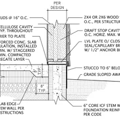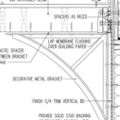Restored steel casement window solutions?
After doing some thermal investigation, I have restored a bunch of late ’50s steel casement windows for use on an addition. I had found a place, Innerglass, that made interior, spring loading, storm windows that sounded like they would take my casements from beautiful to practical.
However, recently I have read about “magnetic bellow” design window inserts, so I am looking for advice.
I live in central Illinois. Lots of the casements will be facing south. I know these windows arent the smart choice, but I really like them.
Any advice on how to make these windows the best they can be, thermally, would be greatly appreciated.
GBA Detail Library
A collection of one thousand construction details organized by climate and house part










Replies
Re-glazing the originals with a hard-coat low-E glass and putting low-E storm windows on the EXTERIOR would be a bigger thermal improvement than any interior storm window, despite the inconvenience of exterior storms on casement windows. But I suppose you've already re-glazed them with un-coated clear glass(?).
Steel frames are an order of magnitude more conductive than wood/fiberglass/vinyl, and it's hard to turn them into great performers, but putting the steel frames inside a less-conductive and tight exterior storm is better than the interior storms which are harder to make air-tight.